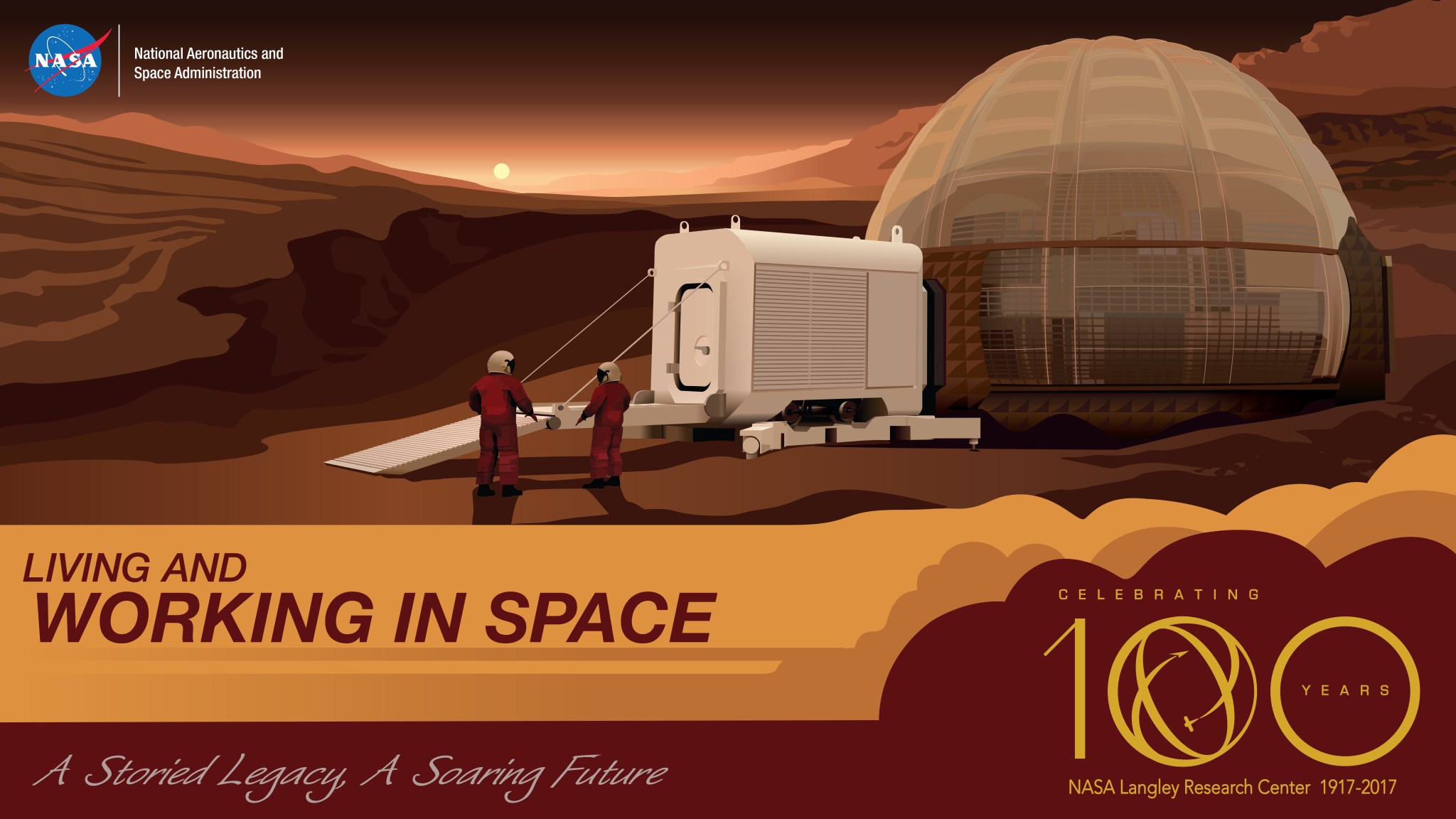Beyond the far horizon, beyond the pull of land, beyond the rush of air and flux of water lies a place deadly to unprotected terrestrial life. The frontier of space nonetheless calls irresistibly through a star-studded vacuum: vast, harsh, a compelling human preoccupation as no other. To help humanity safely enter space, live there for a time, explore, return and, perhaps one day, even make space and near-Earth planets a permanent home, NASA Langley has deployed its expertise since the first days of crewed missions.
Well before Sputnik and the first American spaceflight undertaken by astronaut Alan Shepard, Langley engineers studied ways to create an orbital waypoint, a place looking down but also out: where spacecraft could be launched for travel throughout the solar system and Earth could be observed for a variety of purposes. Development of, and the details involved with, such a “space station” was the focus of a Langley-based team known as the Manned Space Laboratory Research Group. Its work continued throughout the 1950s and into summer 1968.
The Langley studies were used in part to develop Skylab, the United States’ first space station that rocketed to orbit in 1973. In turn, Skylab paved the way for eventual deployment of the International Space Station (ISS), assembly of which began in 1998, with initial crew occupation in November 2000. A Langley experiment was the first to be conducted on board the ISS.
Space, Routinely
Getting routinely to and from low-Earth orbit isn’t easy. Put a large-scale space station permanently in orbit, and there must be reliable means to build, resupply, service and maintain it, as well as safe transference of crews back to and forth from Earth. One such potential fly-to-orbit craft, that of a lifting body, was evaluated at NASA centers, including Langley. Data from Langley wind tunnel tests of the HL-10 model vehicles – an earlier U.S. Air Force concept, the Dyna-Soar, was also put through its paces at Langley in the late 1950s and early 1960s – laid the foundation for development of NASA’s space shuttle fleet, the nation’s premiere reusable spacecraft.
Langley engineers suggested the shuttle’s modified delta-wing concept, evaluated and eventually certified the shuttle’s thermal protection system, and conducted design, analysis and simulation studies of the future orbiters’ flight control and guidance systems. Langley hosted landing tests on shuttle main and nose gear tires and brake systems, and researchers conducted runway surface-texture studies, work that repaved the primary shuttle landing runway at Kennedy Space Center.
Tragedy would strike the shuttle fleet, first in January 1986 with the Challenger accident, and then again in February 2003, with the loss of Columbia. After Challenger, Langley engineers evaluated the joints that failed during launch, and suggested a new design to correct future problems. For its part, Columbia broke apart because a piece of errant foam damaged its thermal protection system, or TPS. Langley focused its technical strengths on the TPS: what could make it fail, how to inspect the TPS without harming it, how to repair it on orbit, and when it was safe to fly even with minor damage.
A New Chapter
Upon the retirement of the shuttle fleet in summer 2011, space devotees were concerned: would the U.S. surrender its role as preeminent space power? What would replace America’s shuttle fleet? Those concerns had already been anticipated: NASA’s commitment to commercial spaceflight development opened a new chapter to travel to low-Earth orbit. The goal: enlisting companies to launch from U.S. soil next-generation rockets and spacecraft capable of, first, ferrying cargo and, eventually, crew to the ISS.
A case in point is Sierra Nevada Corporation’s (SNC) Dream Chaser Space System, based on the HL-20 lifting body concept initiated by and explored at Langley during the 1980s and ‘90s. Langley and SNC joined forces to update and incorporate in the Dream Chaser HL-20 design elements. To refine the vehicle, SNC has worked with Langley on wind tunnel tests, and Langley has helped develop a cockpit simulator at an SNC Colorado-based facility, with flight simulations assessed locally at the center.
In addition, Langley has worked with Boeing’s CST-100 Starliner spacecraft mockup on a series of design-evaluation tests. Although the CST-100 would nominally descend from orbit under parachutes with inflatable bags cushioning the crew landing, water-impact studies at Langley have been performed to ensure crew safety in case the spacecraft makes a quick return to Earth during an abort scenario and with no opportunity to land on terra firma. Langley wind tunnel tests have also been conducted to measure the forces buffeting the Starliner capsule during different phases of its flight.
Safe Space Homes
Flying through the no-atmosphere vacuum of space is one thing, living in it (or near it) quite another. Look for a suitable home, and one solution literally pops up: tough, inflatable structures lighter in weight for easier transport but ones that can withstand radiation, impacts from fast-traveling micrometeroids and the rough-and-tumble of living in an Earth-atmosphere-challenged environment.
Langley has helped evaluate one such inflatable concept, a 12-foot diameter lunar habitat made of multilayer fabric connected to an airtight door. Langley studied ways the structure could incorporate health-monitoring systems, radiation protection, even means of self-healing if damaged. Such a construct could be used as a connector or tunnel between crew quarters, and a reliable shelter from radiation storms if covered by the lunar soil known as regolith.
Langley researchers have proposed another potentially promising habitat, the “Mars Ice Home,” which would be deployed with simple robotics, then filled with water before any crew lands on the Martian surface. No need to burrow underground, since this large inflatable shaped like an inner tube would protect against human-damaging radiation and double as a rocket-fuel storage tank for future Red Planet takeoffs. Plus, a small lifestyle bonus: sunlight would pass through the surrounding materials to convey a Martian glow to any working away inside, safe and secure.






























